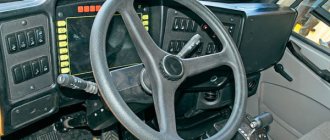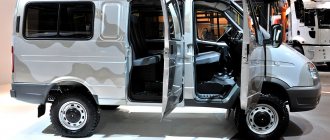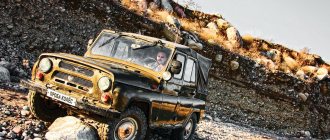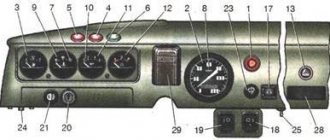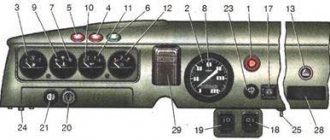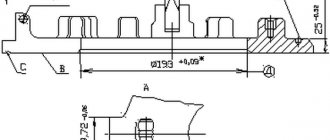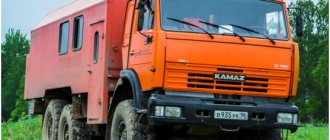* Look at UMZ Engines /full list/
The Ulyanovsk Motor Plant (UMZ) is part of the Light Commercial and Passenger Vehicles division of the largest Russian automobile manufacturing holding GAZ Group.
UMP is one of the large enterprises of the Russian engineering complex producing power units of various modifications for trucks, passengers and multi-purpose vehicles of the GAZ and UAZ brands.
The main products of the plant are gasoline engines UMZ-4216 and EvoTech 2.7, their dual-fuel (gas-gasoline) modifications corresponding to the environmental class "Euro-4" and "Euro-5" for light commercial vehicles of the GAZ brand ("GAZelle", "Sobol").
The most popular commercial vehicles and SUVs in Russia - GAZelles and UAZs - are equipped with engines from the Ulyanovsk Motor Plant - the famous UMZ.
The history of the Ulyanovsk Motor Plant began back in 1944, but the first UMZ brand engine was produced by the company only in 1969 (before that the plant produced a variety of small engines and engine parts) - it was UMZ-451. Since then, UMZ brand engines have faithfully served in the famous UAZ off-road vehicles and light trucks.
The production of automobile engines in Ulyanovsk began with the production of GAZ-21A and ZMZ-451 engines with a displacement of 2.5 liters from the Zavolzhsky Motor Plant. By the beginning of the 90s, these engines had undergone several stages of modernization and had practically exhausted their capabilities to improve energy, fuel and economic characteristics.
At the same time, the increase in consumer qualities of serial UAZ vehicles as a result of their modernization, development and development of new models based on the UAZ-3160, UAZ-3165 led to the need to create engines with increased torque and increased maximum power.
In this regard, Volzhskie Motors JSC developed and began serial production in 1996 the engine model 421.10 with a displacement of 2.9 liters, which made it possible to increase the torque and power of the newly developed engines to 22.5 kgf*m and 110- 112 l. With.
The new engine is completely interchangeable with engines with a displacement of 2.5 liters and can be installed on previous production vehicles without any modifications.
Since 1998, Volzhskie Motors JSC has been supplying model 4215.10 engines with a displacement of 2.9 liters to power a number of modifications of light-duty trucks of the GAZelle family.
To meet the increased requirements for reducing the toxicity of engines, Volzhskie Motors JSC in 1999-2000. started producing engines model 4213.10 with a displacement of 2.9 liters, gasoline injection and microprocessor control of fuel supply and ignition, which are installed on vehicles of the UAZ-3160 family.
Specifications
According to the operating instructions for the Ural walk-behind tractor, the product consists of a frame made of steel profile. The frame is equipped with a power unit, a clutch mechanism and an additional 2-speed gearbox. The power unit is installed through rubber shock absorbers that reduce vibration on the controls.
For movement, 2 wheels are used. The walk-behind tractor uses solid rubber tires with a diameter of 430 mm and a width of 110 mm. Fixed track width - 540 mm. The walk-behind tractor is controlled by handles attached to the frame. The handles are used to turn, change engine speed and change gears. The steering can be adjusted depending on the height of the operator. A bar with holes is used for adjustment.
- length - 1880 mm;
- width - 690 mm;
- height - 1280 mm.
On the front of the frame there is a pin used for installing attachments. The pin is housed in a steel housing bolted to the cross member. There are 2 holes in the body of the pin through which attachments are secured. On the rear cross member there is a bracket designed for installing towed equipment.
The engine installed on the walk-behind tractor requires regular maintenance with partial or complete disassembly. After 250 hours of operation, the valves need to be ground in and adjusted. There are marks on the gears to set the valve timing. Adjustment of the gap between the pushers and valves is carried out using a special screw located at the end of the pusher.
The manufacturer allows a variation in the length and height of products within 50 mm, and in width - within 20 mm. The weight of the equipped device is 120 kg, the weight of the towed trailer is 350 kg. The maximum speed is 11.5 km/h. For the fastest possible movement, a combination of the highest gear in the engine and higher speed in the additional gearbox is used.
Ural with UMZ-5V engine
The engine of the Ural UMZ-5V walk-behind tractor is a 4-stroke, 1-cylinder gasoline unit with a volume of 475 cm³. The motor was originally created for use on self-propelled agricultural machinery and stationary installations. The power unit develops a power of 4.5 liters. With. at 2000 rpm. The plant allows a short-term increase in power up to 5 hp. With. by increasing the speed.
Long-term operation at high power is not allowed, as it leads to overheating.
The engine is equipped with an air cooling system. To cool the engine, a fan is used that forces air into a casing located around the cylinder and head. When operating a walk-behind tractor, it is necessary to regularly inspect and clean the cooling fins from dust and oil. Accumulated dust impairs heat transfer and causes local overheating, which leads to increased engine wear.
The motor is equipped with an automatic speed controller. For this, a centrifugal mechanism is used, which does not allow a rotation speed of more than 2350 rpm. When the speed is exceeded, the throttle valve shifts, which leads to a drop in rotation speed. The engine manufacturer prohibits self-adjustment of the rev limiter, as well as its use to control the speed.
The gas distribution system consists of 2 lower valves. Because of this, the engine has a low compression ratio of 6 units. The engine uses automobile gasoline A-76 (A-80) as fuel. The fuel supply is located in a tank located above the engine carburetor; the liquid is supplied by gravity. The fuel reserve in the tank is 6 liters, which provides an operating time of up to 4-4.5 hours. Operating time depends on the condition of the engine and the nature of the tasks performed.
The engine of the Ural walk-behind tractor is equipped with a 2-speed gearbox with reduction gears. The first speed reduces the rotation speed by 6 times and is used to perform work with a high coefficient of resistance (for example, plowing virgin soil). The second speed reduces the speed by 2.91 times and is used for operating the product with a trailer or when plowing soft soil. Switching the speeds of the UMB-K Ural walk-behind tractor according to the instructions is carried out with the engine not running.
The engine is started with a cord that is wound around the flywheel. Before starting, it is necessary to set the crankshaft to the compression end position. Starting the engine is permitted in 1st or 2nd gear of the motor gearbox.
The engine output shaft is equipped with a 2-ribbed pulley designed to transmit torque to an additional gearbox and to drive attachments. On the fan side there is a second pulley used to drive attachments that require increased rotation speed of the working parts. The clutch mechanism consists of belts and tension rollers.
According to the repair instructions, the transmission crankcase of a walk-behind tractor with a UMZ-5V engine is filled with 1.5 liters of transmission oil. The substance is poured through a hole closed with a plastic stopper.
The standard set of attachments for the walk-behind tractor included a cultivator. To transport cargo weighing up to 350 kg, a 2-wheel TOP-350/350M trolley was used. When using a single-body plow, the installation of an adapter device is required, which is attached to the frame. The plow can be used in conjunction with metal wheels equipped with lugs. A mounted potato digger is used in conjunction with a plow.
Wrong size, wrong metal and not too precise: what’s wrong with the cylinder head of the UMZ engine?
Cheap and cheerful
It's no secret that many car owners, in order to save money, are willing to spend a long time running around car markets and spending hours on the Internet looking for cheap spare parts.
Of course, as a rule these are not original spare parts. We will not say unequivocally that all analogues are spare parts of poor quality (this is not true). But out of curiosity, we went on an experiment: we took the UMZ engine block head from a third-party manufacturer and asked specialists from United Engineering Center LLC of the GAZ Group to check whether this cylinder head complies with the requirements of the plant’s design documentation. That is, is it a complete analogue of the factory cylinder head? The choice of spare parts fell on Tanaki products. This part (TKG-1003010-68) is theoretically an analogue of the UMZ A274.1003010-20 block head (gasoline modification of the Evotech engine for GAZelle). Its cost is 28,980 rubles, the cost of the original cylinder head produced by UMP JSC differs slightly from the cost of the analogue and, oddly enough, to a lesser extent - 28,520 rubles. The head, of course, is assembled - with valves and everything else. As you noticed, this is not a cheap analogue, which will not be expected to reach the quality of the original, but a version of the part that is close in price. But is it really that close in quality?
The results of the research in the laboratory were not entirely surprising, but a little upsetting. To be honest, I wanted to write this material easily, as I love, but it didn’t work out: there are too many numbers. But, alas, there is no reason for jokes at all. So let's take a serious look at what's wrong with this cylinder head.
A little past
Let's start with the precision of manufacturing cylinder head parts. And the first parameter that interests us is the deviation from the flatness of the cylinder head working surface. We have design documentation from the plant, in which this parameter is limited to 0.035 mm. The deviation of the test head was 0.038 mm. Of course, it doesn’t fit into the norm, but I can’t say that the deviation is too large. Antifreeze will not mix with oil, but this is an unpleasant fact.
At the same time, the laboratory noted that all the mounting holes and the location of the channels in the cylinder head were made quite accurately, so there should be no difficulties with installing this head on the engine. This makes me happy. But not much, because then the fun begins.
The volume of the combustion chamber according to the design documentation should be from 67.5 to 68.5 cubic meters. cm. And on our sample it is 70.2 - 70.6 cubic meters. see. This is a rather serious deviation from the specified parameters. The volume of the combustion chamber affects the compression ratio, so we can say that it will definitely not be as good as it was intended at the factory. The most possible consequences of such a deviation are a decrease in power and an increase in fuel consumption. But this is just the beginning.
UMP combustion chamber shape
Shape of combustion chamber TANAKI
According to the documentation, valve bushings can have a deviation from cylindricity of no more than 0.006 mm, on the sample there are deviations of up to 0.008 mm, and their seats do not pass the geometry test. For those who like exact numbers, I will give these figures, although it is a little boring. So, the intake valve seats should have the following parameters: Ø41.2±0.02/ 90°±30', and on the analogue they are Ø41.775 - 41.837/ 89°23' - 89°40'. For release it should be Ø38.6±0.02/ 90°±30', on the analogue - Ø38.674 - 38.756/ 88°51' - 89°12'. In general, this is a complete miss, both with the diameter of the saddles and with the angle of the edges.
I won’t bore you with numbers, I’ll say it in words: the geometric parameters of the intake valves (diameter and angles) of this cylinder head also did not meet the requirements of the design documentation, but the exhaust valves were within the tolerances.
I note that despite numerous deviations in geometry, the valve mechanism successfully passed the leak test (the old fashioned way - with kerosene). That is, it will work. But, most likely, not for long, as we will discuss below.
Some details and geometric parameters of the cylinder head from Tanaki turned out to be within normal limits. For example, the valve seat runout and exhaust valves fit into the frame. However, the laboratory gave an opinion not only on the geometry of the cylinder head, but also on the materials. And there the picture turned out even sadder.
From what was
There is probably no need to tell what will happen if you mold the head of a block from foil and sticks. But I will still allow myself to comment on some points, because it will be very disappointing when the new cylinder head fails unexpectedly quickly. And she will definitely do it.
Let's start with the good news: the hardness and porosity of the cylinder head corresponds to the documentation. I’ll leave one more note for the curious: the hardness must be at least 70 HB, for the test sample it was 97.7 HB, which fits within the CD parameters. The porosity should be 1-2 points; for the sample it is less than one point, which is also good. But that’s where the good news ends, and the pattern begins to break. More precisely, design documentation.
Exhaust valve seats must be made of heat-resistant special cast iron. But for some reason on the Tanaki cylinder head they are made of iron-based powder material. Apparently, it’s cheaper, but if they wear out quickly (in particular, they burn) - that’s the buyer’s problem. Intake seats can be made from powder (KD allows this), and the sample has them made from it. True, with violations in the content of copper, nickel and chromium. Therefore, the laboratory assessed the intake seat materials negatively, and rightly so. And for this, besides the materials themselves, there is another, more significant reason: the saddles do not have the necessary hardness. The hardness of the intake seats should be in the range of 250 - 350 HB, but for the sample it is only 187 HB. The issue is no better: instead of 48 - 60 HRC, there are only 20 HRC. This is already a complete failure.
But the hardness of the valve stem and end turned out to be quite good. At a standard of 32…42/>49 HRC for the inlet valve of the sample it is 36/52.5 HRC, for the exhaust at a standard of 32…42/>47 the hardness of the rod and end was 39 and 55 HRC, respectively. Here everything fits within the norms with a reserve, there are no complaints.
There are no questions about the depth of hardening of the valves, they are normal. But the issue is again a little different: there is no heat-resistant surfacing. Let me remind you that exhaust valves operate at very high temperatures, so such a deviation from the design documentation is simply unacceptable. Well, the material of the exhaust valve itself also does not correspond to the documentation in terms of the content of some metals.
What does this mean? For exhaust valves - rapid burnout. For the engine - loss of compression, which will be quite difficult and expensive to restore.
Among the minor deviations, it is worth noting the insufficient hardness of the valve support washer (32 HRC instead of the required 57 and above) and insufficient compression force of the outer springs. Against the backdrop of global valve problems, these are just trifles, although not very pleasant.
Compression, burnout, bankruptcy
What can you say about the quality of this cylinder head? I would say unequivocally: I would not stage it. At the same time, most likely, she will be able to work well at first. Another thing is that it won't last long.
Despite some not very significant deviation from the flatness of the working surface, there will be no catastrophic consequences. Compression, most likely, will not suffer either (at least due to valve leaks, which are all right here), unless the cylinder-piston group itself is in order. There are questions about maintaining the compression ratio set by the factory: after all, the volume of the combustion chambers differs noticeably from the original, and this will affect power, torque and efficiency. This is, of course, sad, but you can survive it.
But what you can’t get over is the fact that this block head is simply not capable of working for a long time. The lack of heat resistant overlay on the exhaust valves is simply a fiasco. As well as a significant lack of hardness of the valve seats. There is a fear that these valves will burn out faster than necessary, and considering that this is the head of a gas-gasoline engine, they can burn out very quickly. This attitude towards materials is simply unacceptable.
I won’t explain what the risk of burnout is - you understand everything yourself. Loss of compression, loss of power, tripping, excessive fuel consumption - all this is very unpleasant, especially for a GAZelle, that is, a commercial vehicle that should earn money, and not suck it out of the owner.
The most annoying thing is that this cylinder head will not even allow you to save on buying a spare part: it costs no less than the original. But it is quite capable of making you spend money on repeated repairs very quickly.
In general, there is no sense of savings here, unfortunately. It smells like problems in the form of fragility and the need for quick re-repairs. It is advisable to use original or at least high-quality spare parts, because walking on a rake is not only painful, but also very offensive. And for a businessman driving a GAZelle is completely unacceptable.
Ural with ZiD engine
Small batches of walk-behind tractors were equipped with a ZiD-4.5 power unit. The design of the motor is not very different from the UMZ-5V. The crankshaft contains a pulley and a sprocket for driving the chain. The pulley is located on the flywheel side, the chain drive is located on the gearbox side. The chain drive is used to drive stationary installations. The engine is lubricated by splashing; oil is supplied by a plunger pump from a sump that holds 1.5 liters of liquid.
Ural with a Chinese engine
Many owners of Ural walk-behind tractors do not have enough power from the standard power unit. Instead, Chinese engines or other imported motors are often used. The Chinese engine is installed on a standard frame through additional cross members. The cross members are attached to the frame by welding or bolts. Imported power units have an increased crankshaft speed, so the use of homemade pulleys in the clutch is required.
The increased power of the power unit expands the possibilities for do-it-yourself modifications. The equipment is capable of working in winter with an installed rotary snow blower.
Price of new and used Ural walk-behind tractor
Today, the Ural UMZ 5V walk-behind tractor is not mass-produced, so it will not be possible to purchase it without mileage. The model is available only on the secondary market. The average cost of equipment ranges from 10,000 to 30,000 rubles (the difference is determined by the year of manufacture and the condition of the device). When purchasing, you should carefully inspect the car, since the walk-behind tractor engine, despite its reliability, does not last forever, and repairing it will cost a significant amount.
Advantages and disadvantages
Based on reviews of the Ural walk-behind tractor model range, a number of advantages can be identified:
- The weight of the product is 120 kg, so during operation there is no need to exert additional physical force on the control handles;
- possibility of alteration and modernization;
- the engine on the Ural walk-behind tractor with gearbox has a long service life;
- an effective air purifier that does not require replacement of filter elements;
- simplicity of design and the possibility of self-repair.
Owners note the following disadvantages:
- oil leaks at the joints of engine parts and gearbox;
- the need to check the oil level;
- increased fuel and engine oil consumption due to the design of the gas distribution mechanism;
- The walk-behind tractor is not suitable for long trips with a trailer due to the low speed.
Owner reviews and prices
Ural products with ZiD or UMZ engines are valued by owners at an amount from 9 to 15 thousand rubles. Walk-behind tractors with Chinese engines are rare on sale; their cost is in the range of 14-20 thousand rubles.
The walk-behind tractor is used for plowing a personal plot. There were problems with the ignition during operation. After installing a contact ignition coil for a VAZ car, the situation improved. Instead of a magneto, a battery from a computer uninterruptible power supply unit is used. The ignition operates steadily throughout the entire speed range. The engine is stopped by turning off the battery power.
Dmitry, Kaluga region
The walk-behind tractor was purchased along with a house and land in the village. Maintenance requirements are low, the engine started after replacing the spark plug, wire and adjusting the ignition gaps. During operation, you have to compensate for the slight tilt to the side caused by the heavy flywheel. A92 gasoline is used for operation, since A80 fuel is not produced.
Reviews
The Ural UMZ 5V is not suitable for those who plan to cultivate their plot without much effort, since not everyone can pull a machine weighing 120 kg. Compared to the Neva or Oka walk-behind tractors, it is much more difficult to work with. That is why it is better to use it on small areas.
Production of the model began in Soviet times, which makes itself felt. Equipment owners complain about regular oil leaks. However, serious breakdowns with a walk-behind tractor are extremely rare. Usually you have to change small elements: gear plug, armored wire, spark plug, etc. Using its “native” power plant, the Ural UMZ 5V can operate for 20-30 years without failures.
special equipment is positioned as a vehicle, but it is not intended for long-distance transportation. On the road, the model can cause a lot of problems. The walk-behind tractor begins to consume a lot of gasoline and oil. At the same time, the Ural UMZ 5V engine becomes very noisy. When moving, you can hear the rattling of iron.
The power plant of the walk-behind tractor stands out for its power. The owners praise her, calling her a real “beast.” The engine can withstand almost any operating conditions, unlike foreign engines. Heat, long-term and heavy load are not scary for the UMZ 5V unit. Among the negative aspects, its noise should be highlighted.
The advantages of the walk-behind tractor include domestic assembly. Ural UMZ 5V breaks down very rarely. However, if this happens, the owner will be able to find spare parts for it as soon as possible. Their cost will be significantly less than that of foreign models.
Multifunctionality is not a strong feature of this model. Only a few operations can be performed using technology. In this indicator, it is significantly inferior to modern walk-behind tractors, which stand out for their versatility.
The Ural UMZ 5V is quite a solid piece of equipment, but it is intended exclusively for plowing and cultivating the land, since even moving a load on it is not so easy.
Engine for walk-behind tractor Ural UMZ-5A, UMZ-6A, UMZ-5B
The UMZ-5B engine and its modification UMZ-5DU-B are a four-stroke, single-cylinder, air-cooled internal combustion gasoline engine and are intended for installation on self-propelled agricultural machines, and can also be used on stationary installations for the mechanization of various agricultural works.
The engine has a two-stage gearbox with gear ratios of 1:6 and 1:2.91, changing the speed of the output shaft. The UMZ-5DU-B engine has the same parameters as the UMZ-5B engine and differs in that it is equipped with a single-stage gearbox with a gear ratio of 1:6 and a gearbox shaft without a ratchet.
The engine was installed on Ural walk-behind tractors, which many still have and still serve today. It is difficult to find operating instructions, so we created this page for those who use Ural walk-behind tractors with UMZ-5A, B, UMZ-6A engines. You can download instructions from our website:
Operating instructions for the UMZ-5A, UMZ-5DU-A engine
Operating instructions for the UMZ-5B, UMZ-5DU-B engine
Operating instructions for the UMZ-5V engine for the Ural walk-behind tractor - download - this manual was sent by visitors to our website.
Brief description of the UMP plant
Ulyanovsk Motor Plant was founded in 1944. The main production facilities are located in the city of Ulyanovsk, Ulyanovsk region, Russian Federation. The plant produces UMZ engines, which are currently purchased by GAZ, UAZ and PAZ. The Ulyanovsk plant produces gasoline power units, which are famous for their reliability and simplicity throughout the CIS.
Produced engines
OJSC Ulyanovsk Motor Plant produces a fairly large assortment of gasoline engines, which are widely used in many brands of cars from domestic automakers. Thus, throughout the history of production, the UMZ engine was installed on such legendary cars as UAZ Bobik, UAZ Tabletka, UAZ 469, Gazelle, UAZ Patriot and others.
Motoblock "Ural"
Motoblocks "Ural-UMP-5V" first began to be sold in the country just before its global redistribution at the dawn of the 90s of the last century. Since many people needed walk-behind tractors as a convenient and cheap technical tool, it became very popular in the USSR. In just a few years, its sales reached 150 thousand units. The optimal combination of its characteristics contributed to the popularity of the walk-behind tractor.
The developers were able to combine the high performance of the walk-behind tractor, which was achieved by a five-horsepower gasoline unit that accelerates it to a speed of 15 km/h, combined with battery power sufficient to cultivate up to 2 hectares of arable territory. In addition, the unit could transport cargo weighing up to half a ton.
The walk-behind tractor has a wide adjustable ground clearance, which allows the device to be used in different types of areas. But it is worth noting that the basic Ural model is not particularly multifunctional. It can only transport cargo and cultivate the soil. It will not be possible to mow grass, remove debris or snow using attachments with this type of equipment - such capabilities are not provided. But if you remake the design yourself, adding the necessary fastening units, you can expand its functionality.
Video review
The Ural UMZ 5V has a wide track, which the owner can customize based on operating conditions and type of terrain. This function allows the equipment to become easier to use and faster. The track width varies within several tens of centimeters.
The model is not multifunctional and is functionally inferior to the products of the Minsk Tractor Plant. Ural UMZ 5V is used only for transportation and soil cultivation. There are no attachments, nozzles for mowing grass, removing garbage or snow. The walk-behind tractor is suitable for those who plan to use it in the summer for work on the site.
The design of the equipment includes a transmission that transmits power from the engine through the differential. Some modifications of the walk-behind tractor are equipped with a more powerful foreign unit, which increases the efficiency of the equipment. However, most consumers choose the domestic option with accessible and cheap parts. Ural UMZ 5V has four gears, which allows you to choose the optimal speed for a particular job.
Formally, the model belongs to the Russian automotive industry. The walk-behind tractor is reliable and does not require regular maintenance. Most owners of Ural UMZ 5V have not changed the elements for decades, limiting themselves to only a few consumables. However, to maintain normal operation, the manufacturer recommends periodically diagnosing the chassis and engine.


